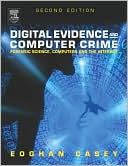Digital Evidence and Computer Crime
Search in google:
Digital evidence—evidence that is stored on or transmitted by computers—can play a major role in a wide range of crimes, including homicide, rape, abduction, child abuse, solicitation of minors, child pornography, stalking, harassment, fraud, theft, drug trafficking, computer intrusions, espionage, and terrorism. Though an increasing number of criminals are using computers and computer networks, few investigators are well-versed in the evidentiary, technical, and legal issues related to digital evidence. As a result, digital evidence is often overlooked, collected incorrectly, and analyzed ineffectively. The aim of this hands-on resource is to educate students and professionals in the law enforcement, forensic science, computer security, and legal communities about digital evidence and computer crime. This work explains how computers and networks function, how they can be involved in crimes, and how they can be used as a source of evidence. As well as gaining a practical understanding of how computers and networks function and how they can be used as evidence of a crime, readers will learn about relevant legal issues and will be introduced to deductive criminal profiling, a systematic approach to focusing an investigation and understanding criminal motivations. Readers will receive access to the author's accompanying Web site which contains simulated cases that integrate many of the topics covered in the text. Frequently updated, these cases teaching individuals about: * Components of computer networks * Use of computer networks in an investigation * Abuse of computer networks * Privacy and security issues on computer networks * The law as it applies to computer networks
AcknowledgmentsDetailed Table of ContentsAuthor BiographiesIntroduction1Pt. 1Digital Investigation7Ch. 1Digital Evidence and Computer Crime9Ch. 2History and Terminology of Computer Crime Investigation25Ch. 3Technology and Law41Ch. 4The Investigative Process91Ch. 5Investigative Reconstruction115Ch. 6Modus Operandi, Motive, and Technology147Ch. 7Digital Evidence in the Courtroom169Pt. 2Computers191Ch. 8Computer Basics for Digital Investigators193Ch. 9Applying Forensic Science to Computers211Ch. 10Forensic Examination of Windows Systems255Ch. 11Forensic Examination of Unix Systems289Ch. 12Forensic Examination of Macintosh Systems323Ch. 13Forensic Examination of Handheld Devices337Pt. 3Networks357Ch. 14Networks Basics for Digital Investigators359Ch. 15Applying Forensic Science to Networks383Ch. 16Digital Evidence on Physical and Data-Link Layers419Ch. 17Digital Evidence on Network and Transport Layers441Ch. 18Digital Evidence on the Internet477Pt. 4Investigating Computer Crime519Ch. 19Investigating Computer Intrusions521Ch. 20Sex Offenders on the Internet561Ch. 21Investigations Cyberstalking601Ch. 22Digital Evidence as Alibi617Pt. 5Guidelines625Ch. 23Handling the Digital Crime Scene627Ch. 24Digital Evidence Examination Guidelines633Bibliography645Glossary665Author Index675Subject Index677








